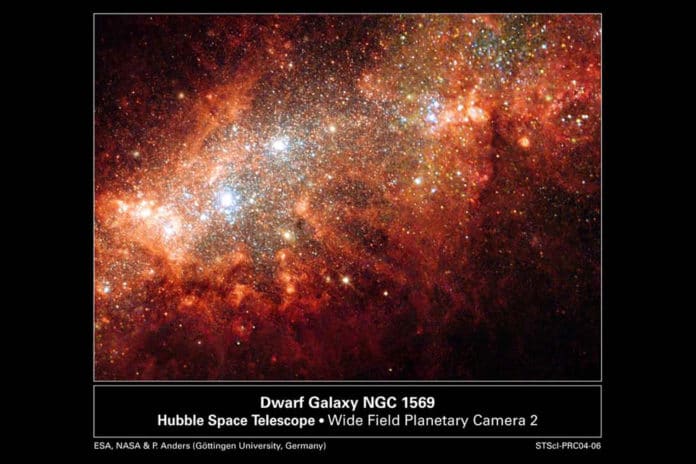NASA’s Hubble Space Telescope shared a glimpse of a glittering dwarf galaxy NGC 1569. The galaxy is located nearly 11 million light-years away. It is considered as the sanctuary of vigorous star birth activity, which blows huge bubbles that riddle the main body of the galaxy.
Characterized by a large starburst, the star formation rate of the galaxy is 100 times greater than that of the Milky Way. It contains two prominent super star clusters plus many smaller star clusters. Those two super star clusters are similar to globular star clusters found in Milky Way.
The recent image shared by Hubble shows that the galactic super-winds and outflows created by a tremendous input of energy from collective supernova explosions related to a massive episode of star creation sculpt the bubble structure.
The color image is composed of 4 different exposures with Hubble’s Wide Field and Planetary Camera 2 through the following filters: a wide ultraviolet filter (shown in blue), a green filter (shown in green), a wide red filter (shown in red), and a Hydrogen-alpha filter (also shown in red).
The bubble-like structure is made of hydrogen gas that glows when hit by the fierce winds and radiation from hot young stars. The fascinating fact is that supernovae shocks rack the structure.
The first supernovae blew up when the most massive stars reached the end of their lifetimes roughly 20-25 million years ago.
On Jan. 1, 2004, a group of European astronomers published a paper describing NGC 1569 in great detail. The group used several of Hubble’s high-resolution instruments, with deep observations spanning a wide wavelength range, to determine the parameters of the clusters more precisely than is currently possible from the ground.
The team found that most of the clusters in the galaxy are formed in an energetic starburst event that started around 25 million years ago and lasted for about 20 million years.
The environment in NGC 1569 is still turbulent. Its supernovae might be delivering the gaseous raw material needed to form further stars and star clusters and actually trigger their birth in the tortured swirls of gas.
